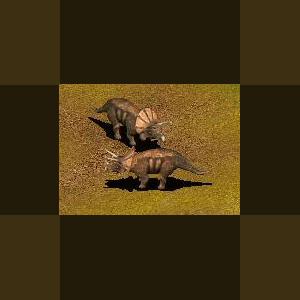About This File
Chasmosaurus (KAZ-mo-sawr-us) is a ceratopsid dinosaur genus from the Upper Cretaceous Period of North America.
Ceratopsians are split into two subfamilies by taxonomists; those with short frills
(centrosaurines), such as Centrosaurus and those with long frills (chasmosaurines), of
which Chasmosaurus was one. In addition to the larger frill, the long-frilled ceratopsians
typically had longer faces and jaws and it is suggested by some paleontologists that they
were more selective about the plants they ate. Long frills were a relatively late
development in dinosaur evolution, since even Chasmosaurus dates from the late Cretaceous
Period, 76 to 70 million years ago. The frill of Chasmosaurus has been described as
"heart-shaped", since its bone structure consists of two large 'loops' from a central bone.
Some finds include a number of smaller ossifications (called epoccipitals), which may have
grown from the perimeter of the frill. The frill may also have been brightly colored, to
draw attention to its size or as part of mating display. However, the frill was so large
and yet so flimsy (since it was mainly skin stretched between the bones) that it could not
have provided much functional defense. It is possible that it was simply used to appear
imposing or conceivably for thermoregulation. In the event of a chasmosaur herd being
attacked by a predator (such as Tyrannosaurus), the males could have formed a ring and,
with all the frills facing outwards, would have presented a formidable sight.
A drawing of Chasmosaurus.Like many ceratopsians, chasmosaurs had three main facial horns - one on the nose and two on the brow. Different fossil finds have produced inconclusive
results - one species of Chasmosaurus, named C. kaiseni, bore long brow horns, while C. belli had only short ones. Although these were initially named as different species, it now seems possible that the long horns belonged to males and the shorter horns to females.
Interestingly, a Chasmosaurus specimen recovered by Sternberg was accompanied by
fossilized skin.The skin appears to have had many bony knobs (osteoderms) in evenly spaced rows, with five or six sides per knob. Unfortunately, nothing can be learned about the coloration of Chasmosaurus from the known fossil skin samples.
Inspired by the Zoo Tek Brains Trust



Recommended Comments
Create an account or sign in to comment
You need to be a member in order to leave a comment
Create an account
Sign up for a new account in our community. It's easy!
Register a new accountSign in
Already have an account? Sign in here.
Sign In Now